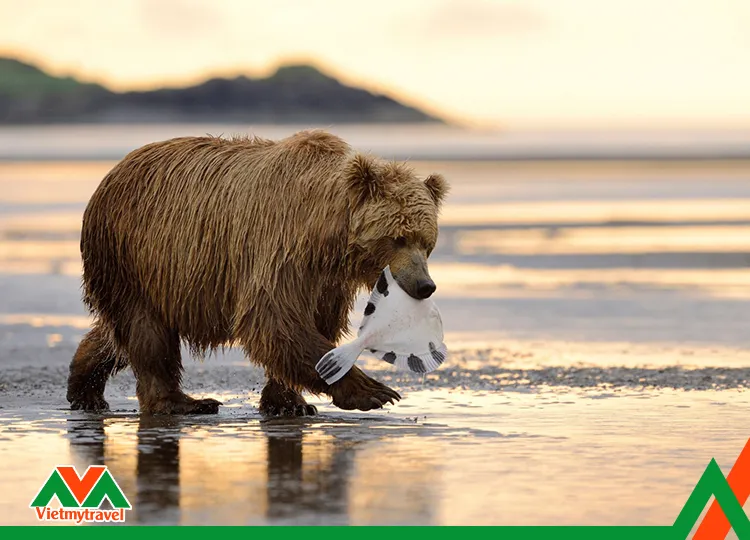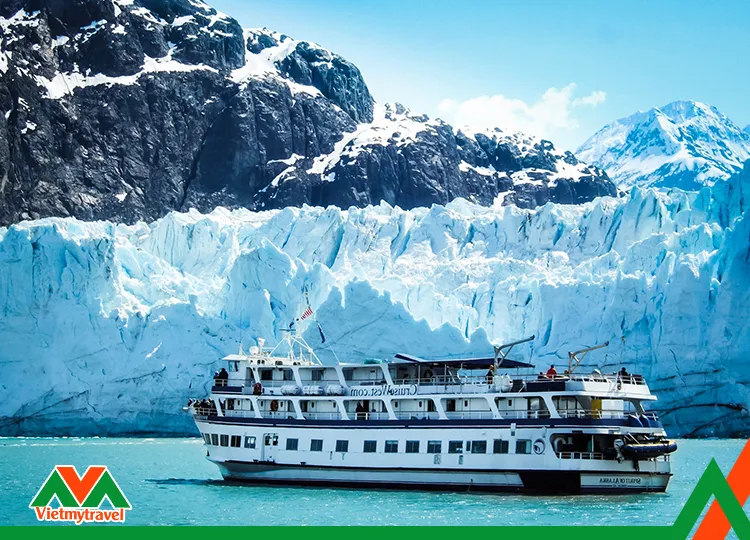Alaska, the last frontier of the United States, is a paradise for landscape photography enthusiasts. With majestic snow-capped mountains, magnificent glaciers, pristine coastlines, and diverse wildlife, Alaska offers countless opportunities to create breathtaking photos. This article serves as a detailed guide to help you discover and capture the unique beauty of Alaska through your camera lens, focusing on must-visit locations during your exploration of this land.
Alaska is not just a tourist destination; it’s an endless source of inspiration for any photographer. The light in Alaska is exceptional, from the brilliant golden sunshine of summer to the long-lasting sunrises and sunsets, creating moments of wonderful colors. Coupled with the wilderness and grandeur of nature, you will be overwhelmed and driven to capture every moment. In this article, we will explore the most beautiful landscape photography locations in Alaska, from the wildlife conservation center to Prince William Sound and historical gold mines, while sharing tips and techniques to help you create the most impressive photos.
Alaska Wildlife Conservation Center: Immerse Yourself in Wilderness
The Alaska Wildlife Conservation Center (AWCC) is an ideal stop for those who want to photograph wildlife in a natural yet safe and accessible environment. Unlike typical zoos, AWCC is a non-profit organization specializing in rescuing and rehabilitating injured or orphaned native animals. Here, you will have the opportunity to admire and photograph brown bears, caribou, moose, foxes, wolves, and many other rare bird species in a vast space that closely resembles their natural habitat.
To capture impressive wildlife photos at AWCC, you should prepare a telephoto lens with a focal length of 200mm or more. A versatile zoom lens like 70-200mm or 100-400mm will be very useful for adjusting the frame to suit the distance and size of the animals. Pay attention to the light and shooting time. Early morning or late afternoon is usually when animals are most active, and the light is also softer, creating photos with more depth and beautiful colors.

When photographing animals, be patient and observe their behavior. Don’t rush to shoot as soon as you see an animal; take time to observe to capture their most natural and expressive moments. For example, you can wait for the moment a brown bear catches a fish, caribou graze, or a bald eagle spreads its wings and soars. Use continuous shooting mode to avoid missing any moments.
Besides animals, AWCC also has beautiful natural scenery with majestic mountains and clear blue lakes. Take advantage of these elements to create impressive animal landscape photos, where animals blend into their habitat. Use a wide-angle lens to capture the vast scenery, combined with a telephoto lens to focus on the details of the animals.
Prince William Sound: Glacier Wonderland and Wildlife
Prince William Sound is a gem of Alaska, famous for its majestic glaciers flowing into the sea, magical icebergs, and rich wildlife. Cruising on the sound is an unmissable experience to explore its beauty and capture memorable moments with your camera.
When photographing landscapes at Prince William Sound, you will face vast and majestic scenes. A wide-angle lens is an indispensable companion so you can capture the entire grandeur of glaciers, mountains, and the ocean. Pay attention to the composition of the frame, using the rule of thirds or leading lines to create depth and interest in the photo.
The light at Prince William Sound can change very quickly due to weather and fog. Always be ready to adjust your camera settings to suit the current lighting conditions. Shooting on sunny days will give vibrant colors and high contrast, while cloudy days create soft light and more harmonious colors. Both lighting conditions offer unique beauty, depending on your style and ideas.

One of the special highlights of Prince William Sound is the icebergs. They come in all shapes and sizes, from small ice chunks like diamonds to giant ice blocks like castles. Look for unique shooting angles to highlight the beauty of the icebergs, such as close-ups of ice textures, iceberg reflections on the water, or icebergs in the vast landscape of the sound.
In addition to icy landscapes, Prince William Sound is also home to many marine wildlife species such as sea otters, seals, whales, and seabirds. You can photograph wildlife from a boat, but you will need a powerful telephoto lens to capture clear photos from a distance. Be patient, observe, and wait for moments when animals appear, such as humpback whales breaching, sea otters playing in the waves, or seabirds flying in the sky.
Crow Creek and Indian Valley Gold Mines: Explore History and Scenery
Alaska experienced a historic gold rush in the 19th century, and gold mines like Crow Creek and Indian Valley still retain traces of that era. Visiting these gold mines is not only an opportunity to learn about gold mining history but also a chance to explore unique landscapes and take photos.
Crow Creek and Indian Valley gold mines are located in a mountainous and forested setting, offering wild and ancient beauty. You can take panoramic photos of the gold mines from above to see their scale and integration with the surrounding nature. Use a wide-angle lens to capture the entire gold mine area, including mining structures, trails, and small streams.
One of the interesting subjects to photograph at the gold mines is the old mining tools and equipment. Rusty ore carts, wooden water pipes, abandoned houses… all bear the mark of time and tell stories of the past. Capture close-up details of these items to highlight the beauty of antiquity and nostalgia. The soft light of early morning or late afternoon will enhance the antique and romantic feel of these photos.
In addition, you can also experience gold panning at the gold mines and document this process with photos. Photograph gold panners working intently, close-ups of sparkling gold nuggets in the pan, or radiant smiles when gold is found. These photos will not only capture moments but also tell stories about the lives and passions of gold seekers.
The scenery around the gold mines is also worth exploring and photographing. Gurgling streams, lush pine forests, snow-capped mountains… all create a harmonious and charming natural picture. Take time to walk around the gold mine area and look for beautiful shooting angles to capture the beauty of Alaskan nature.
Tips for Taking Professional-Looking Alaska Landscape Photos
To capture beautiful and impressive Alaska landscape photos, you need to master some basic tips and techniques:
- Golden Hour and Blue Hour: These are the two most ideal times for landscape photography. Golden hour is the short period after sunrise and before sunset, when the light is soft, warm, and creates long shadows, highlighting the shapes and depth of the scenery. Blue hour is the period just after sunset or before sunrise, when the sky is deep blue and the light is soft, creating a romantic and mysterious atmosphere.
- Use Filters: A polarizing filter helps reduce glare, increase contrast, and make colors more vibrant, especially effective when photographing the sky, clouds, and water. An ND (neutral density) filter helps reduce the amount of light entering the lens, allowing you to shoot with a slower shutter speed to create motion blur effects for flowing water or moving clouds, even in bright light conditions.
- Tripod: A tripod is an indispensable tool for landscape photography, especially when shooting in low light conditions or when using slow shutter speeds. A tripod helps stabilize the camera, prevent shaking, and allows you to capture sharp and detailed photos.
- Composition: Composition is a crucial factor determining the success of a landscape photo. Apply basic composition rules such as the rule of thirds, leading lines, symmetry, or foreground-middle ground-background to create depth and balance in the photo.
- Weather: Weather has a significant impact on the light and colors of the landscape. Don’t be afraid to shoot in bad weather conditions like rain, fog, or snowfall. These weather conditions can create unique and impressive photos that are distinctly Alaskan.
- Patience: Landscape photography requires patience. Sometimes you have to wait for hours to get beautiful light, a moment when animals appear, or the weather to change as desired. Be patient and don’t give up; the results will be worth your effort.
Conclusion
Alaska is an endless treasure trove for landscape photography enthusiasts. From majestic mountains and magnificent glaciers to pristine coastlines and diverse wildlife, Alaska offers countless opportunities to explore and capture the unique beauty of nature. With the guidelines and photography tips shared in this article, hopefully you will have more tools to conquer Alaska and create dreamlike landscape photos. Prepare your camera, hit the road, and discover Alaska – a photography paradise awaits you!